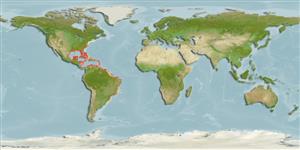Actinopterygii (ray-finned fishes) >
Tetraodontiformes (Puffers and filefishes) >
Ostraciidae (Boxfishes)
Etymology: Lactophrys: Latin, concerned with milk + Greek, ophrys = eyebrow (Ref. 45335).
Environment / Climate / Range
Ecology
Marine; reef-associated; depth range 2 - 50 m (Ref. 9710). Subtropical, preferred ?; 45°N - 34°S, 98°W - 34°W
Western Atlantic: Canada (Ref. 5951), Massachusetts (USA) to Brazil, including Bermuda, the Gulf of Mexico and the Caribbean. Mediterranean Sea (Ref. 50345).
Size / Weight / Age
Maturity: Lm ? range ? - ? cm
Max length : 55.0 cm TL male/unsexed; (Ref. 40637); common length : 30.0 cm TL male/unsexed; (Ref. 5217); max. published weight: 3.3 kg (Ref. 40637)
With small diffuse white spots; two areas where the hexagonal plates are dark-edged, forming chain-like markings, one on the pectoral region of the body and the other half way between gill opening and posterior end of carapace; large individuals lose the pale spots and chain markings and develop an irregular dark reticulate pattern over the entire carapace and caudal peduncle (Ref. 13442).
Inhabits seagrass beds, coral rubble areas, and offshore reefs down to about 50 m. Feeds on a wide variety of small benthic invertebrates such as mollusks, crustaceans, worms and sessile tunicates, as well as some sea grasses (Ref. 3696). Highly esteemed food fish in the Caribbean (Ref. 3696).
Life cycle and mating behavior
Maturity | Reproduction | Spawning | Eggs | Fecundity | Larvae
Robins, C.R. and G.C. Ray, 1986. A field guide to Atlantic coast fishes of North America. Houghton Mifflin Company, Boston, U.S.A. 354 p. (Ref. 7251)
IUCN Red List Status (Ref. 115185)
CITES (Ref. 94142)
Not Evaluated
Threat to humans
Reports of ciguatera poisoning (Ref. 4690)
Human uses
Fisheries: commercial; aquarium: commercial
More information
Common namesSynonymsMetabolismPredatorsEcotoxicologyReproductionMaturitySpawningFecundityEggsEgg development
ReferencesAquacultureAquaculture profileStrainsGeneticsAllele frequenciesHeritabilityDiseasesProcessingMass conversion
Tools
Special reports
Download XML
Internet sources
Estimates of some properties based on models
Phylogenetic diversity index (Ref.
82805): PD
50 = 0.6250 [Uniqueness, from 0.5 = low to 2.0 = high].
Trophic Level (Ref.
69278): 3.3 ±0.3 se; Based on diet studies.
Resilience (Ref.
69278): High, minimum population doubling time less than 15 months (Fec assumed to be > 10,000).
Vulnerability (Ref.
59153): Low to moderate vulnerability (32 of 100) .
